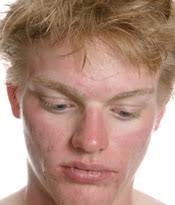 Ocular rosacea, as they may be on rosacea as the variance in the severity and intensity of rosacea vary from one person to another. Ocular rosacea is an inflammatory eye disease often described associated with acne rosacea. Ocular rosacea can ignite into a persistent feeling of burning and graininess in the eyes or swollen eyelids with small inflamed bumps. The eyes may be bloodshot and eyelashes sometimes fall out (Dr. THIBOUTOT). The rosacea ophthalmic signs are extremely variable, including blepharitis, conjunctivitis, iritis, iridocyclitis, hypopyoniritis and even keratitis. (These conditions will be described in detail below.) The term ophthalmic rosacea covers all these signs. The rosacea ophthalmic complications are independent of the severity of facial rosacea.
Ocular rosacea, as they may be on rosacea as the variance in the severity and intensity of rosacea vary from one person to another. Ocular rosacea is an inflammatory eye disease often described associated with acne rosacea. Ocular rosacea can ignite into a persistent feeling of burning and graininess in the eyes or swollen eyelids with small inflamed bumps. The eyes may be bloodshot and eyelashes sometimes fall out (Dr. THIBOUTOT). The rosacea ophthalmic signs are extremely variable, including blepharitis, conjunctivitis, iritis, iridocyclitis, hypopyoniritis and even keratitis. (These conditions will be described in detail below.) The term ophthalmic rosacea covers all these signs. The rosacea ophthalmic complications are independent of the severity of facial rosacea.The most common signs that may never progress to a serious condition, are chronically inflamed margins of the eyelids with scales and crusts, quite similar to seborrheic dermatitis, with which ocular rosacea is often confused. Pain and photophobia (abnormal light sensitivity) be present. Check For this reason, a rosacea sufferer to react as their eyes from bright sunlight, like the eyes very sensitive to sunlight. The ocular complications are independent of the severity of facial rosacea (Drs. Gerd Plewig and Albert M. Kligman). Rosacea keratitis is an unfavorable prognosis, and in extreme cases can cause corneal opacity with blindness. Ocular rosacea may be combined with keratitis leading to blindness.
Statistics show that more than fourteen million people suffer from some form of rosacea, it is easier or harder. To develop about 60% of patients with rosacea-related problems), the eyes (ocular rosacea. Ocular rosacea is a condition in which travels the facial image of rosacea redness in the eyelids and in some cases the inner eye area found itself in one study (Starr, McDonald 1969) it was found that ocular rosacea symptoms occurred in 58% of patients. Patients with ocular rosacea most commonly experience irritation of the lids and eye, occurs when the sebaceous glands to impede the lids. Signs and symptoms of ocular rosacea can also chronically red eyes and lid margins, irritated eyelids (blepharitis), barley grain (Hailstone), dry, irritated eyes, burning and the feeling of a foreign body in the eye. Ocular rosacea may involve the cornea, which neovascularization (abnormal blood vessel growth), infections, and occasionally ulcers.
With ocular rosacea are frequently frustrated by their chronic eye disease. It is reported that 50 affected and 60% of all rosacea, also have ocular rosacea. Found in one study (Starr, McDonald 1969) it was found that ocular rosacea symptoms occurred in 58% of patients. One treatment that has shown to be in the treatment of ocular rosacea, Rosacea-Ltd III is effective.

0 comments:
Post a Comment